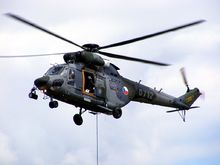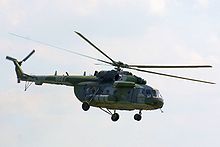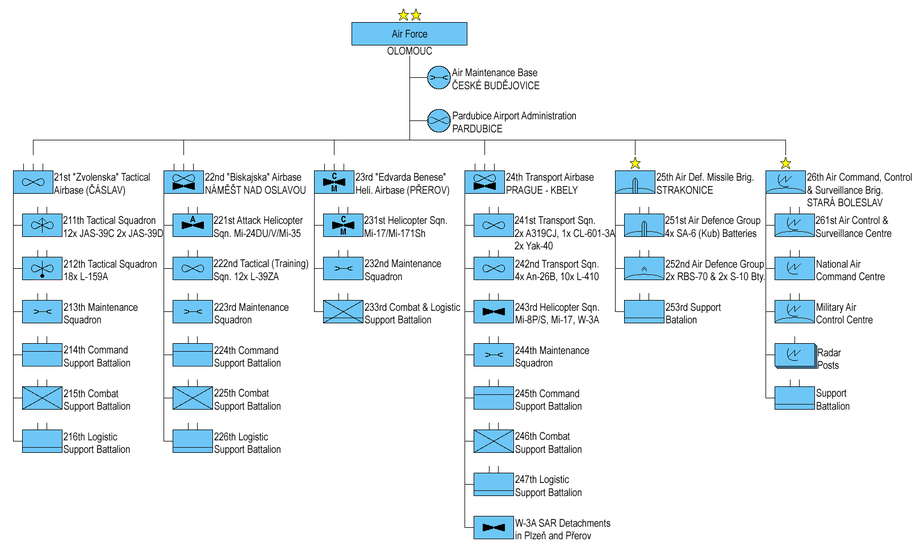- Czech Air Force
-
Air Force of The Czech Republic 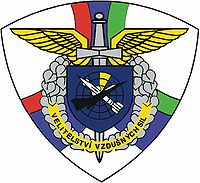
Founded 1 January 1993 Country  Czech Republic
Czech RepublicPart of Armed Forces of The Czech Republic Joint Forces Command Olomouc Motto Air is our sea Commanders Deputy Joint Forces Commander Brigadier General Jiří Verner Insignia Roundel 
Low-visibility roundel 
Aircraft flown Attack Aero L-39, Aero L-159 Fighter JAS 39 Gripen Helicopter Mi-17/171, Mi-24/35, W-3A Trainer Aero L-39, Aero L-159, Zlin Z 142 Transport CASA C-295M, Bombardier Challenger CL-601, Airbus A319, Let L-410, Yak-40 The Czech Air Force is the air force branch of the Armed Forces of the Czech Republic. The Air Force, with the Land Forces, comprises the Joint Forces, the main combat power of the Armed Forces of the Czech Republic. It succeeded the Czechoslovak Air Force together with the Slovak Air Force in 1993.
The Air Force is responsible for securing the integrity of the Czech Republic's airspace through the NATO Integrated Air Defense System - NATINADS, close air support to the Land Forces and for transportation tasks including government and state priority flights.[1]
Contents
History
Further information: Czechoslovak Air Force#HistoryCzech Republic (1993–present)
The separation saw a large reduction in types, numbers and bases. 1994 saw the creation of the 3rd tactical air force corps. The newest fighter in the Czechoslovak Air Force arsenal was the MiG-29 (Izdelie 9.12). As there was only one general maintenance kit, which was given to newly created Slovak Republic, and all the material was split 1:1 with Slovakia, maintenance costs for the Czech Fulcrums would be too high. Along with the unreasonably high costs, speculative costs for spare parts imported from Russia, which were realised through third-party companies (Mil Mi-24 rotor blades acquisitions were over-priced by 400%), led to exchange of 10 MiG-29s with Poland for PZL W-3A Sokół rescue helicopters with avionics and ground support. Therefore 10 air superiority fighters were exchanged for 11 light helicopters, an exchange many[who?] considered to be very uneven. The burden of readiness squadron passed to the MiG-23s. Those participated in air exercises with western air forces, where MiG-23MLs were capable of outperforming Mirage III, F1C, 2000 and F-4F in vertical manoeuvering and acceleration and Mirage III, F1C and Phantom even in horizontal manoeuvering, while being outperformed by F-16A in all aspects and by Mirage 2000 in horizontal manoeuvering.
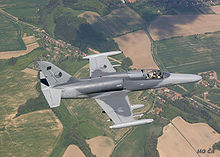 Aero Vodochody L.159A Advanced Light Combat Aircraft of the Czech Air Force
Aero Vodochody L.159A Advanced Light Combat Aircraft of the Czech Air Force
As the Czech Republic prepared to become a member of NATO in 1999, it began to revise and update its doctrines and aircraft. Therefore, acquisition of a new, western fighter was considered. MiG-23MFs were retired in 1994, MLs in 1998 and MiG-21s were reestablished as an interim type for what was supposed to be a transition period before buying a new fighter - which was selected to be Swedish JAS 39 Gripen multi-role fighter aircraft. Because of the devastating floods that hit the country during 2002 the deal was put off.[citation needed]
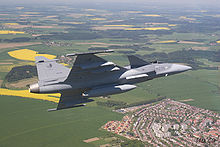 Saab Gripen of the Czech Air Force
Saab Gripen of the Czech Air Force
A new international tender was issued for an interim solution. Gripen again won this tender among six different bidders as the Czech Republic accepted a government to government 10-year lease from Sweden that did not involve BAE Systems. Media allegations of BAE Systems kickbacks to decision makers during the original sales effort have so far led nowhere in the judicial system.[citation needed]
In December 2008, the Czech Air Force wanted to train helicopter pilots for desert conditions for the upcoming mission in Afghanistan. Unfortunately, no country wanted to help except Israel, which saw it as an opportunity to thank the Czech Republic for training Israeli pilots and supporting Israel when it first became a state:[2][3]
Future
In 2015, the lease of the JAS 39 Gripens from Sweden will expire. It is foreseen that the aircraft will then be either returned to Sweden or purchased. The Czech government expects a tender to be organised to provide a force of 18 supersonic fighters after 2015. The JAS-39 Gripen is generally accepted as the most effective option owing to the existing infrastructure, the availability of trained personnel and previous good operational experience. However, the background of the existing contract – specifically the broadly discussed issue of alleged corruption – prevents politicians from settling for this quick solution, favouring instead a general tender with more bidders offering such types as the F-16, F-18, F-15SE or F-35A. [1], [2], [3]
The creation of a non-supersonic air force has also been discussed as an option, owing to the perceived high costs and limited usefulness of keeping supersonic assets in a country surrounded by allied countries (all are European Union members and also NATO members, except Austria). In this scenario the subsonic L-159 would become the backbone of the air force. The latest 2011 White Book [4] clearly states that the supersonic fleet is to be continued for the protection of the Czech Republic and for co-operation within the NATO Integrated Air Defence System. On the other hand, a number of close support helicopters Mi-24/35 will be decommissioned (the Mi-35 will even be sold before the end of its operational life). Twelve single-seat and two twin-seat aircraft are viewed as sufficient for patrolling the Czech Republic, while 18 can support the sentry role in other NATO countries. A preliminary RFI requested 18 aircraft [5]. The White Book specifies the 12+2 solution, requiring strategic requirements for the supersonic air force to be specified by November 2011. Another option being discussed in the Parliament is the formation of a joint force of Czech, Slovak or even Hungarian units responsible for the air protection of these countries. Although it seems to be a financially effective solution (argued mainly by the Social Democrats) [6], its practical realisation would be complicated: Hungary has its own JAS-39s and Mig-29s, while Slovakia has recently upgraded its Mig-29 fleet.
Insignia
The first Czechoslovak military aircraft bore, for a short time between September and November 1918, three-colour roundel, from the middle: red, blue and white. From 27 November 1918 it was replaced with slanted parallel lines in these colours. From 1920 they were replaced with an inverted roundel, from the middle: white, blue and red. From 21 December 1921 national insignia on aircraft became rectangular national flags. Finally, in December 1926 a current roundel of three parts in white, red and blue, was adapted.[4] It remained the insignia of the Czech Air Force until today, although in recent years, a low-visibility variant, all in grey, was adapted in some applications.
Structure
- General Staff - Prague[5]
- Joint Forces Command - Olomouc
- 21st Tactical Air Force Base Zvolenská - Čáslav
- 211th Tactical Squadron - Jas-39C/D Gripen
- 212th Tactical Squadron - L-159A/L-159T1 ALCA
- 22nd Air Force Base Biskajská - Náměšť nad Oslavou
- 221st Attack Helicopter Squadron - Mi-24DU/V/Mi-35
- 222nd Tactical Squadron - L-39ZA
- 23rd Helicopter Base Edvard Beneš - Přerov
- 231st Helicopter Squadron - Mi-17/Mi-171Sh
- 24th Air Transportation Base - Prague–Kbely
- 25th Air Defence Missile Brigade - Strakonice
- 26th Air Command, Control and Surveillance Brigade - Stará Boleslav
- Air Maintenance Base at České Budějovice
- Pardubice Airfield Authority
- 21st Tactical Air Force Base Zvolenská - Čáslav
Flight Training Centre (CLV) Pardubice, operating EV-97, 2xZ-142C-AF, 3xL-39C, Mi-2, L-410 UVP, L-410 UVP-T, 2xMi-17[6] is not a part of the Air Force. Primary flight training was outsourced as of 1 April 2004. CLV is a branch of LOM PRAHA s.p., state owned company.[7]
List of aircraft
The Czech Air Force operates 190 aircraft, including 61 combat aircraft and 84 helicopters. Thirty-seven percent of the Air Force's aircraft were manufactured in the Czech Republic.
Aircraft Origin Type Versions In service[8] Notes Aero L-39 Albatros  Czechoslovakia
Czechoslovakiatrainer
attackL-39C/ZA 7/9[9] Aero L-159 Alca  Czech Republic
Czech Republictrainer
attackL-159T1
L-159A4
20Airbus A319  European Union
European UnionVIP and transport A319CJ 2 replacement of the Tu-154M EADS CASA C-295M  Spain
Spaintransport C-295M 4 Bombardier Challenger 600  Canada
CanadaVIP CL-601 1 Let L-410 Turbolet  Czechoslovakia
Czechoslovakiatransport L-410UVP
L-410UVP-E
L-410UVP-T10[9] Yakovlev Yak-40  Soviet Union
Soviet Uniontransport Yak-40
Yak-40K1
1Mil Mi-8/17/171  Russia
Russiatransport helicopter Mi-8S
Mi-17
Mi-171
21
16Mil Mi-24/35  Russia
Russiaattack helicopter Mi-24V
Mi-3518
10PZL Mi-2  Poland
Polandutility helicopter Mi-2 5 PZL W-3 Sokół  Poland
Polandutility helicopter W-3A 10 Saab JAS 39 Gripen  Sweden
Swedenfighter JAS 39C
JAS 39D12
2leased for 10 years[9] Zlin Z 142  Czechoslovakia
Czechoslovakiatrainer Z 142 8[9] Evektor-Aerotechnik EV 97  Czech Republic
Czech Republicultralight trainer EV 97 1 In addition, several Sojka III unmanned aerial vehicles are operated for reconnaissance and electronic warfare.
Types recently retired from Czech service include:
- Antonov An-26 decommissioned by April 2011 [7] being replaced by the C-295M
- Tupolev Tu-154M Careless serial no. 1003 and 1016 have been out of service since November 2007 being replaced by the Airbus A-319CJ.
- Aero L-29 Delfin single-engine jet trainer, predecessor of L-39
- Antonov An-30 Clank photo version of An-24/26/28 series (1x)
- Mikoyan-Gurevich MiG-21 latest versions (MFN) used for NATINADS (NATO Integrated Air Defence System) service until replaced by Gripens
- Sukhoi Su-22 ground attack aircraft, export version of the Sukhoi Su-17
- Sukhoi Su-25 close air support aircraft
- Antonov An-24V light transport turboprop, predecessor of Antonov An-26 Curl
References
- ^ http://www.army.cz/scripts/detail.php?id=6821 Air Force role and organization
- ^ http://www.ceskenoviny.cz/news/index_view.php?id=350692
- ^ "Czech Helicopters over the Negev Desert" (in Czech). http://www.army.cz/scripts/detail.php?id=12559. Retrieved 17 July 2010.
- ^ Hans-Joachim Mau: Tschechoslowakische Flugzeuge, Berlin, 1987, ISBN 3-344-00121-3
- ^ Jaroslav Spacek, Force Report: Czech Air Force, Air Forces Monthly magazine, January 2009 issue. Retrieved on January 6, 2009.
- ^ http://www.touchdown-aviation.com/reports/2009/centrum-leteckeho-vycviku-lom.php List of CLV aircraft
- ^ http://www.lompraha.cz/en/ LOM PRAHA s.p.
- ^ "World Military Aircraft Inventory", Aerospace Source Book 2007, Aviation Week & Space Technology, January 15, 2007.
- ^ a b c d Czech military aviation OrBat
- Brown, Alan Clifford. The Czechoslovak Air Force in Britain, 1940-1945 (PhD Thesis). University of Southampton, Faculty of Arts, School of Humanities, 1998, 237pp. [8]
- Titz, Zdenek; Davies, Gordon and Ward, Richard. Czechoslovakian Air Force, 1918-1970 (Aircam Aviation Series no. S5). Reading, Berkshire, UK: Osprey Publishing Ltd., 1971. ISBN 0-85045-021-7.
External links
- Global Security entry
- Official Czech Army site
- Book about JAS Gripen in Prague
- Photo galleries of the Czech Air Force
- Photo at Photo Planes.com
- Transcript of Czech Parliament concerning MiG-29 exchange with Poland
Air forces in Europe Sovereign
states- Albania
- Andorra
- Armenia
- Austria
- Azerbaijan
- Belarus
- Belgium
- Bosnia and Herzegovina
- Bulgaria
- Croatia
- Cyprus
- Czech Republic
- Denmark
- Estonia
- Finland
- France
- Georgia
- Germany
- Greece
- Hungary
- Iceland
- Ireland
- Italy
- Kazakhstan
- Latvia
- Liechtenstein
- Lithuania
- Luxembourg
- Macedonia
- Malta
- Moldova
- Monaco
- Montenegro
- Netherlands
- Norway
- Poland
- Portugal
- Romania
- Russia
- San Marino
- Serbia
- Slovakia
- Slovenia
- Spain
- Sweden
- Switzerland
- Turkey
- Ukraine
- United Kingdom
- Vatican City
States with limited
recognition- Abkhazia
- Kosovo
- Nagorno-Karabakh Republic
- Northern Cyprus
- South Ossetia
- Transnistria
Categories:- Air forces by country
- Military of the Czech Republic
- Aviation in the Czech Republic
Wikimedia Foundation. 2010.

